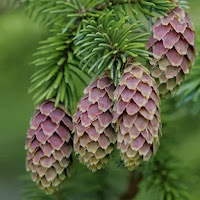The monkey puzzle tree, a type of evergreen tree that grows to a diameter of 1--1.5 meters and a height of 30--40 meters, is now threatened with extinction.
Scientists believe the tree's unusual features, namely spiny leaves and intricate scaly branches, were the result of evolution as a defense against long-necked dinosaurs.
This evergreen tree is said to be one of the survivors of the Jurassic era, more than 145 million years ago, CNN reported, Thursday, August 18, 2022.
The cultivated araucaria araucana grows in gardens and parks around the world, but in the wild, this species grows only along the slopes of the Patagonia volcanoes in Chile and Argentina.
Fires, land clearing, overgrazing, and logging have shrunk the temperate forests where the endangered tree grows. Its large seeds are also a valuable food source for an endemic bird species: the austral parakeet.
The green parrot, which is in a flock of about 15 birds, flies from tree to tree to find a home during the breeding season.
When the birds get the right spot, their numbers can swell to over 100, and they enjoy the monkey puzzle tree pine nuts.
Recent research has found that robber parakeets, despite their unfounded appetite for nuts, could actually help monkey puzzle trees survive in Patagonia.
Scientists say the birds act as a buffer against the threat posed by overharvesting of nuts by humans.
Important role
Parakeets usually pick up pine nuts and eat them from the tops of trees tens of meters high. Often, birds only eat part of the seeds. According to the results of a 2018 study, the removal of some seed coats by parakeets increased the speed of germination of monkey puzzle seeds.
Two study authors, Gabriela Gleiser and Karina Speziale from the Argentine Institute for Biodiversity and Environmental Research at the National University of Comahue, explained, "They (parakeets) play an important role in the regeneration of Araucaria forests because the partially eaten seeds they leave on the ground were not selected by collectors. seeds, and they retain their germination potential."
What's more, they say, parakeets disperse seeds, meaning the tree regenerates further than the parent plant. Gleiser and Speziale also investigated whether parakeets, as they fly from branch to branch, pollinate female cones. In addition, the monkey puzzle tree pine nuts are also a traditional food source for the Mapuche indigenous people of Chile and Argentina.
Illegal Collectors
Mapuche skillfully climbs the cypress tree to collect the seeds and grind them into flour that can be baked into bread. The nut, which is larger than the almond, is also eaten more widely in both countries, especially Chile.
Mapuche has the right to collect peanuts in his ancestral land. However, beyond that, local authorities limit the number of nuts that can be collected for personal and commercial purposes. "That too requires a permit," said Gleiser and Speziale.
"Nevertheless, many illegal collectors collect without respecting collection limits," the researchers noted. "Peanut collection is an important threat to the reproduction of monkey puzzle trees in populations accessible to humans, as illegal seed collectors have almost exhausted the seed pools that trees produce."
However, parakeet damaged nuts are removed by collectors, so partially eaten nuts can still germinate. It is also noted that the Mapuche lifestyle is intertwined with the monkey puzzle tree. However, it was a bond that was nearly broken during the colonial period and into the 1990s, when industrial loggers stripped the land, including Araucaria trees.
30% of World's Tree Species Endangered
According to legal protections for the species, the Mapuche clashed with loggers and the Chilean government.
The monkey puzzle tree is now legally protected throughout Patagonia. "Araucaria are like the Mapuche people ... even though they have been persecuted, beaten, we are all strong," Petrona Pellao, a member of the Mapuche Indigenous group, said in the CNN document Patagonia: Life on the Edge of the World.
"Mapuche are now replanting Araucaria trees and reinventing their ancient ancestral practices. The goal is to help Mapuche cultivate pine nuts sustainably and allow Araucaria trees to thrive once again," he continued.
In fact, according to last year's study, at least 30 percent of the world's tree species are threatened with extinction in the wild. Categories range from the famous oaks and magnolias, to tropical hardwood trees, reports BBC, 1 September 2021.
"We have nearly 60,000 tree species on the planet, and for the first time we now know which species need conservation action, what the greatest threats are to them, and where they are," said Dr Malin Rivers of the charity Botanic Gardens Conservation International. .
Previously, the State of the World's Trees report found that at least 30 percent of the 60,000 tree species are at risk of extinction. About 142 species have become extinct from the wild, while 442 are on the verge of extinction, with fewer than 50 individual trees remaining.


